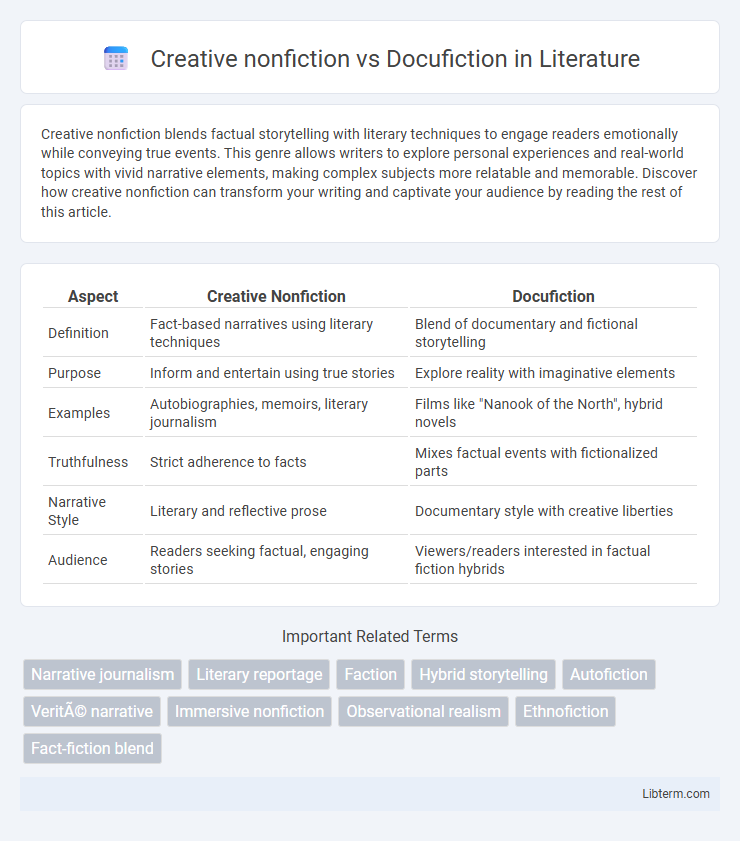Creative nonfiction blends factual storytelling with literary techniques to engage readers emotionally while conveying true events. This genre allows writers to explore personal experiences and real-world topics with vivid narrative elements, making complex subjects more relatable and memorable. Discover how creative nonfiction can transform your writing and captivate your audience by reading the rest of this article.
Table of Comparison
| Aspect | Creative Nonfiction | Docufiction |
|---|---|---|
| Definition | Fact-based narratives using literary techniques | Blend of documentary and fictional storytelling |
| Purpose | Inform and entertain using true stories | Explore reality with imaginative elements |
| Examples | Autobiographies, memoirs, literary journalism | Films like "Nanook of the North", hybrid novels |
| Truthfulness | Strict adherence to facts | Mixes factual events with fictionalized parts |
| Narrative Style | Literary and reflective prose | Documentary style with creative liberties |
| Audience | Readers seeking factual, engaging stories | Viewers/readers interested in factual fiction hybrids |
Understanding Creative Nonfiction
Creative nonfiction blends factual storytelling with literary techniques to engage readers through vivid narratives and personal voice, emphasizing authenticity and emotional truth. This genre employs detailed research, firsthand experiences, and compelling character development to present real events in a narrative format without sacrificing factual accuracy. Understanding creative nonfiction involves recognizing its balance between factual integrity and artistic expression, distinguishing it from docufiction, which incorporates fictional elements into documentary-style storytelling.
Defining Docufiction
Docufiction is a hybrid genre combining documentary and fictional elements to create a narrative that blends factual accuracy with creative storytelling techniques. Unlike creative nonfiction, which strictly adheres to factual events while employing literary style, docufiction introduces dramatized or imagined scenes to enhance emotional depth and audience engagement. This genre challenges traditional boundaries by merging authentic documentation with artistic interpretation to present a more immersive experience.
Origins and Historical Context
Creative nonfiction emerged in the 1960s as a literary genre blending factual reporting with narrative techniques, drawing from traditional journalism and memoir traditions to create immersive storytelling rooted in real events. Docufiction originated in the mid-20th century film industry, combining documentary and fictional elements to portray reality through staged reenactments and scripted scenarios, reflecting an evolution from pure documentary towards hybrid forms capturing subjective reality. Both genres reflect shifting cultural attitudes towards truth and representation, influenced by postmodern critiques of objectivity and the desire to engage audiences emotionally while preserving factual integrity.
Key Elements of Creative Nonfiction
Creative nonfiction emphasizes factual storytelling enriched with literary techniques such as vivid imagery, personal reflection, and narrative structure to engage readers emotionally and intellectually. Key elements include accuracy in reporting, a compelling narrative voice, detailed scene setting, and a strong thematic focus that conveys truth through artful presentation. Unlike docufiction, which blends fact with fictionalized dramatization, creative nonfiction maintains a commitment to factual integrity while using creative expression to deepen understanding.
Essential Features of Docufiction
Docufiction combines documentary and fictional filmmaking techniques to create a narrative grounded in real events while incorporating imaginative elements. Essential features of docufiction include blending factual content with scripted scenes, emphasizing authenticity through real locations and characters, and presenting multiple perspectives to enhance the storytelling depth. This hybrid approach allows for creative expression without abandoning the truthfulness central to documentary traditions.
Narrative Techniques Compared
Creative nonfiction employs literary storytelling techniques such as vivid character development, detailed scene setting, and emotional arcs to present factual content with immersive narrative flair. Docufiction blends documentary authenticity with scripted dramatization, using reenactments, real-life footage integration, and hybrid narrative structures to convey truth with artistic interpretation. Both genres prioritize engaging storytelling but differ in their balance between factual accuracy and creative license, influencing how narrative techniques are applied to shape audience perception.
Fact vs. Imagination: Boundaries and Ethics
Creative nonfiction blends factual storytelling with literary techniques, emphasizing accuracy while employing narrative devices to engage readers emotionally. Docufiction merges documentary and fictional elements, blurring fact and imagination to provoke thought but raising ethical questions about representation and truthfulness. Maintaining clear boundaries and transparency is essential to uphold trust and avoid misleading audiences in both genres.
Popular Works and Notable Examples
Creative nonfiction includes popular works like Truman Capote's "In Cold Blood" and Joan Didion's "The Year of Magical Thinking," which blend factual reporting with literary techniques. Docufiction combines documentary and fictional elements, exemplified by films such as "The Blair Witch Project" and "Catfish," which use real footage and fabricated narratives to enhance realism. Both genres prioritize storytelling but differ in their balance of fact and fiction, appealing to diverse audiences through innovative narrative methods.
Audience Reception and Impact
Creative nonfiction captivates audiences by blending factual storytelling with literary techniques, fostering deep emotional engagement and enhancing credibility through authentic personal narratives. Docufiction merges documentary realism with fictional elements, provoking critical reflection and challenging viewers' perception of truth, often resulting in polarized audience reception due to its ambiguous nature. The impact of creative nonfiction leans towards empathy and understanding, while docufiction drives discourse and questions about reality and representation in media.
Choosing Between Creative Nonfiction and Docufiction
Choosing between creative nonfiction and docufiction hinges on the desired balance between factual accuracy and imaginative storytelling. Creative nonfiction prioritizes authentic, research-based narratives that maintain factual integrity while employing literary techniques to engage readers effectively. Docufiction blends documentary elements with fictionalized scenarios, offering flexibility to explore truth through a narrative that may include dramatized or speculative content.
Creative nonfiction Infographic

 libterm.com
libterm.com